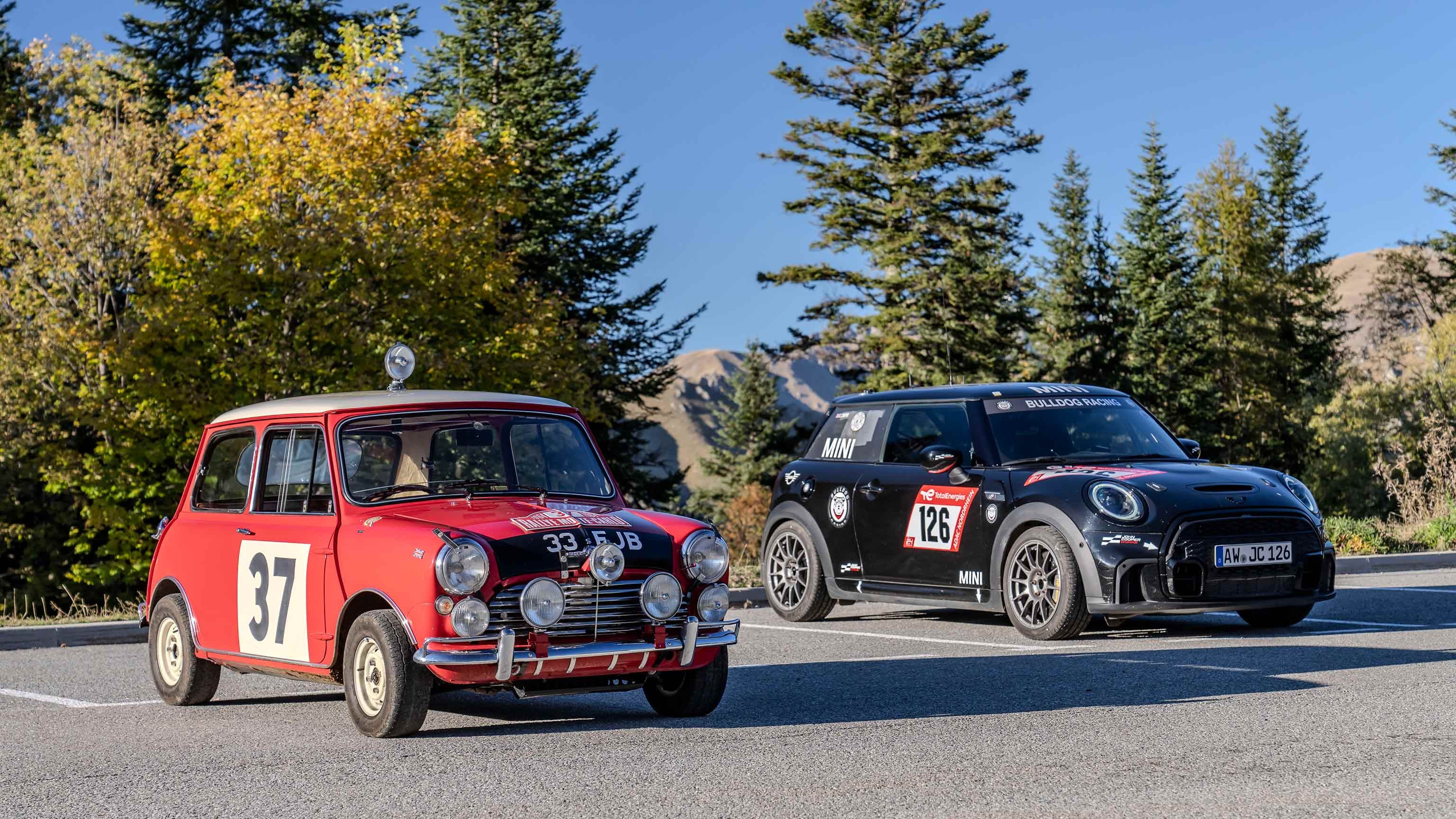Our tool for managing your permission to our use of cookies is temporarily offline. Therefore some functionality is missing.
HERITAGE.
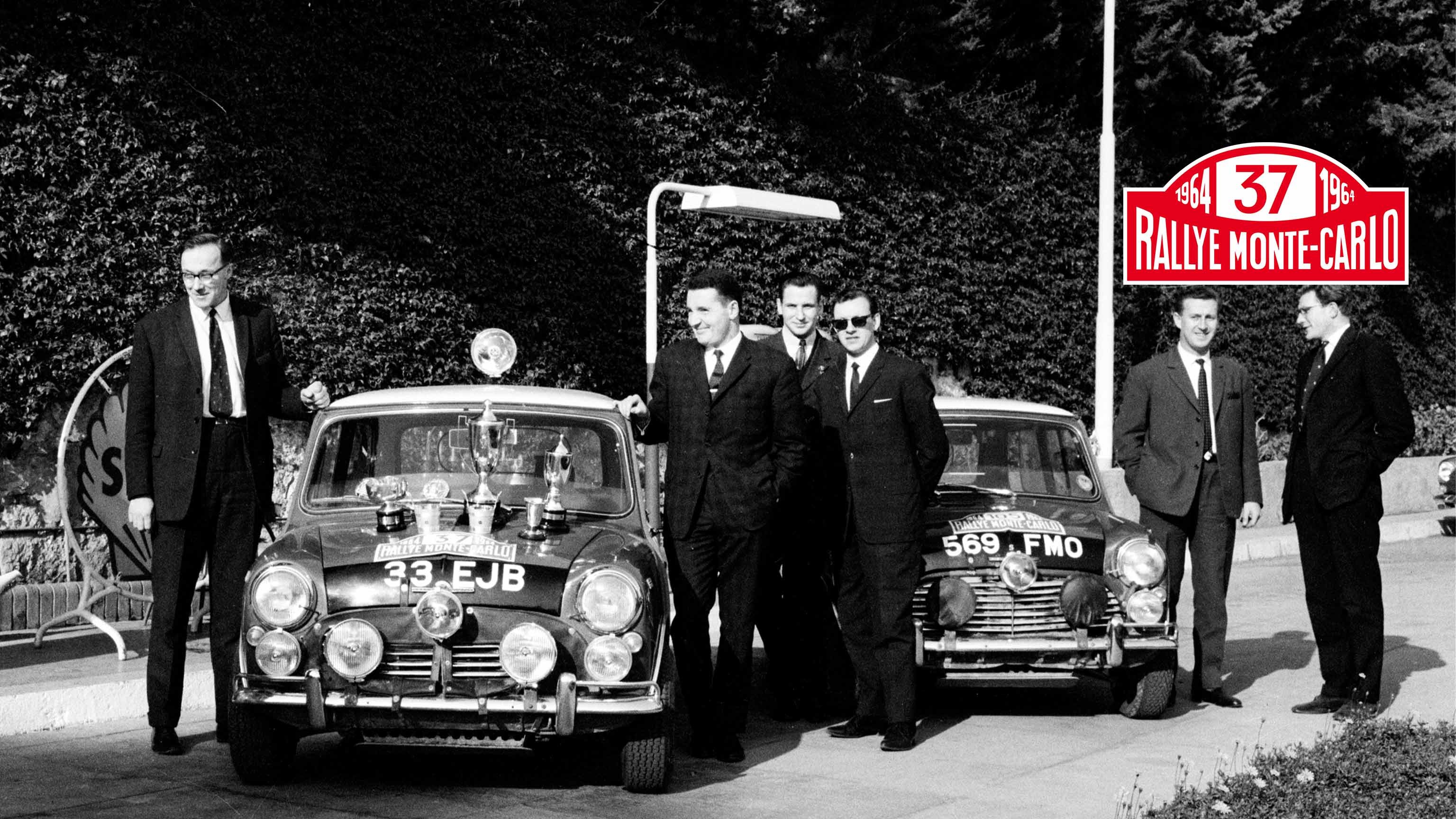
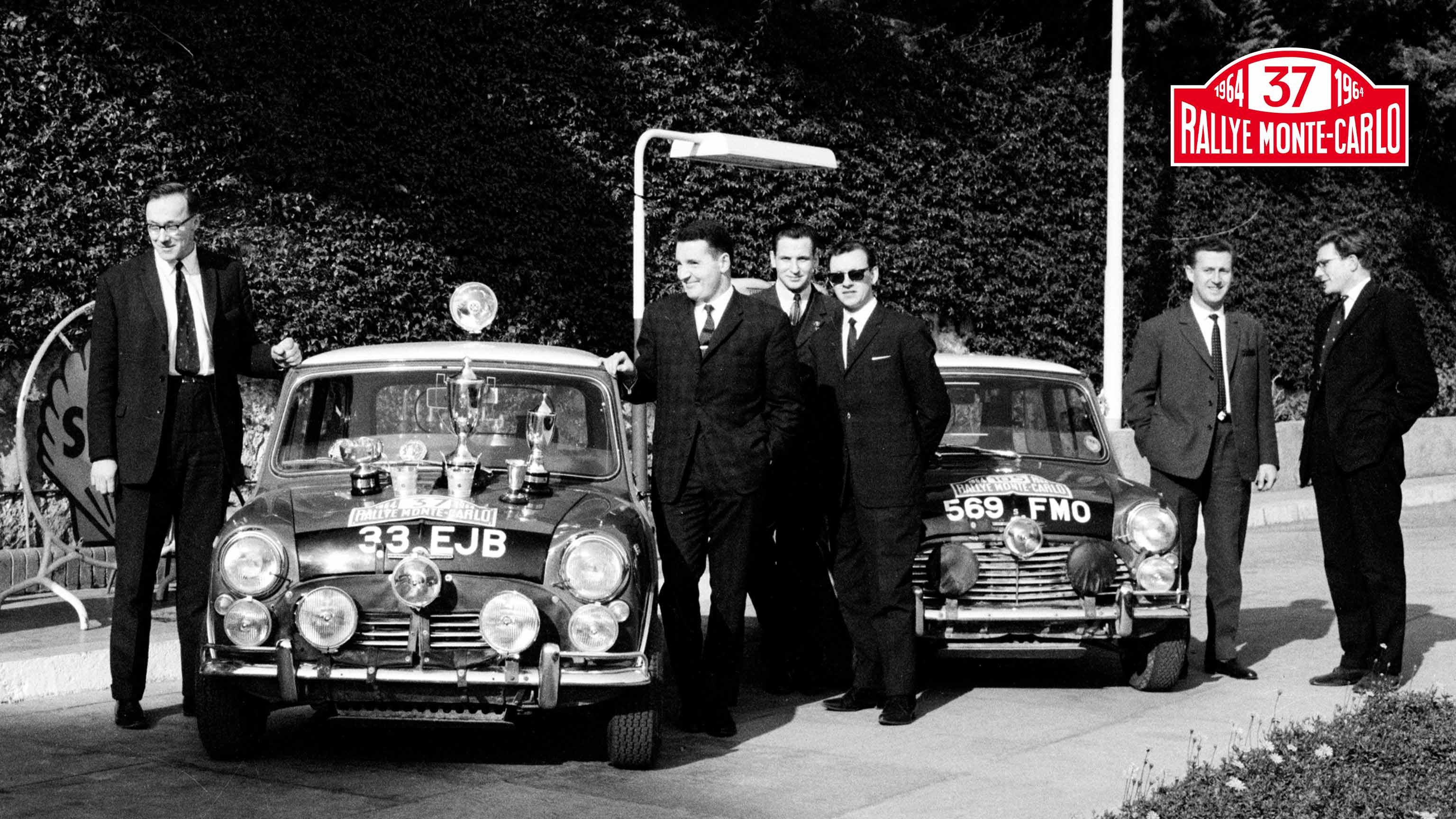
MONTE CARLO RALLY 1964.
WHERE THE MINI MAGIC BEGAN.
When Patrick Hopkirk crossed the Monégasque finish line 60 years ago, the whole racing world held its breath. After a 22-kilometre battle in the most adverse weather conditions, the Tartan Red Mini Cooper S had unexpectedly prevailed against the overwhelming crowd of competitors – heralding a triumphant winning streak that echoes to the present day.
What was the Classic Mini’s secret to outdoing all 276 adversaries? We went in search of the answers, to find out what the Cooper bloodline has to do with it, and why the thrill of the past can still be felt in the newest generation of MINI. Perhaps Charles ‘Charlie’ Cooper – the fourth racing fanatic in the family – has the fascinating backstory we seek.
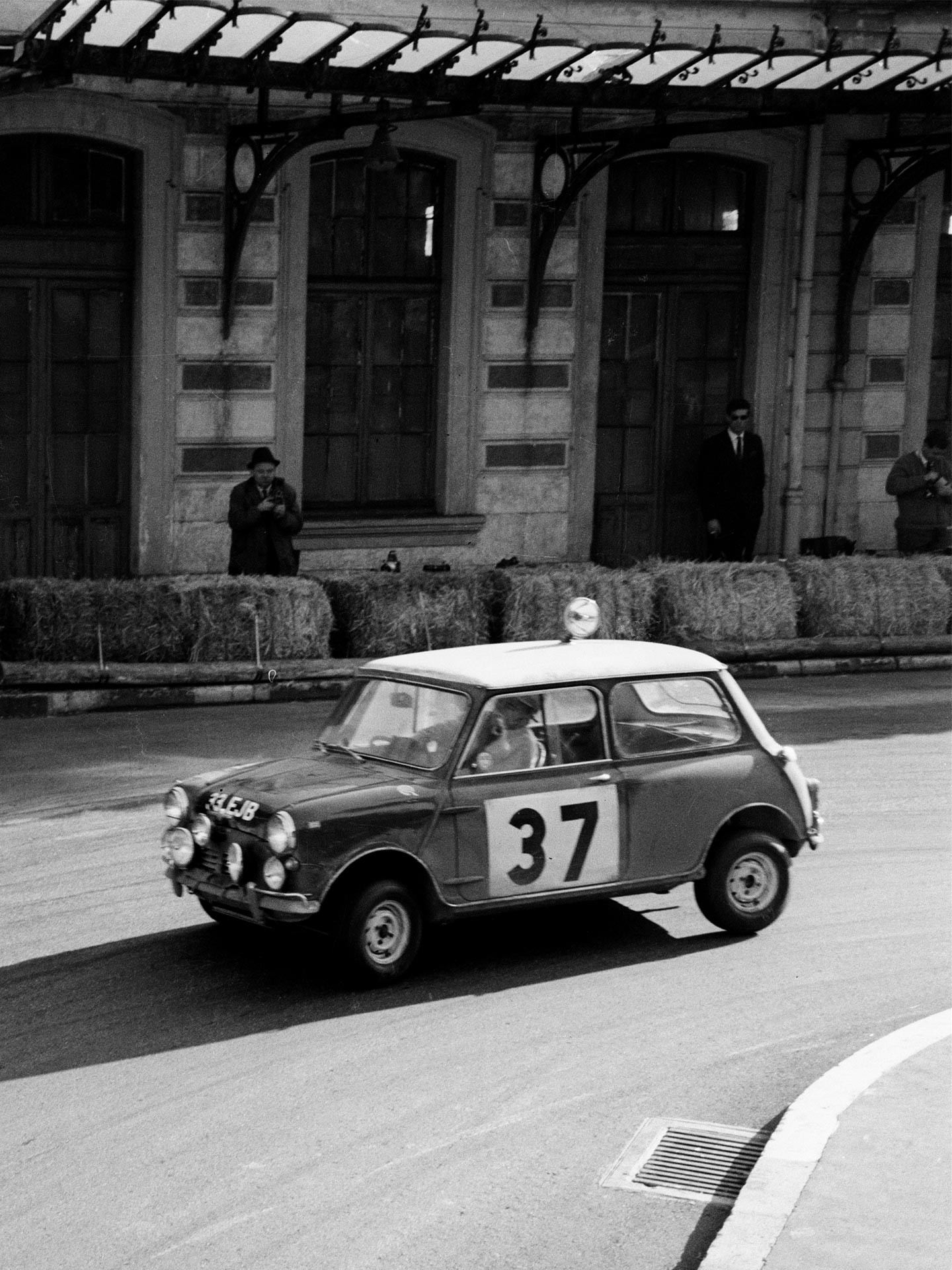
THE OUTSIDER’S
FINEST HOUR.
It was January 18th, 1964, and the starting signal for the 33rd Monte Carlo Rally had just been sounded across nine European cities. Every racing car united by the same goal: to be the first to reach Monaco and dominate the urban canyons just off the Côte d’Azur with lightning speed. The winding journey through the Maritime Alps would demand everything and more from their cars, with its steep slopes, tight bends, snow- and ice-covered mountain passes. There would be no questions as to why the Monte Carlo Rally was deemed one of the most difficult competitions of its kind.
The compact Mini Cooper, originally designed as an economical and affordable city speedster, should not have won. The odds were stacked against the small car given its fierce opponents. Bo Ljungfeldt, in particular, menacing behind the wheel of a powerful V8 Ford Falcon. And while race car engineer and MINI legend John Cooper had managed to increase the displacement to 1071 cm³ and tune the engine to an impressive 90 hp, Mini’s rivals still mobilised three to four times as much power. A power skilfully exploited by Ljungfeldt up until the so-called ‘Night of the Long Knives’ before which a full 65 seconds had separated him from the pack.
But then, the balance tipped.
Size, weight, and rear-wheel drive made it difficult to climb the 1607-metre-high Col de Turini, causing Ljungfeldt’s lead to dwindle. Hot on his heels was pilot Hopkirk, who appeared to float through the huge masses of snow with his Mini’s front-wheel drive, optimal tyre choice, and corner-friendly handling. Even on the kilometre-long full throttle tracks, the ridiculed outsider wasn’t to be left behind.
The final stage through winding Monte Carlo, saw the Swede set a new fastest time and arrive first at the finish line. According to the handicap formula used at the time to equalise the differences in power and weight, the Mini Cooper completed the circuit just half a minute later – landing the big coup and securing top spot in the overall standings.
John Cooper was delighted to recount this legendary moment to his grandson Charlie, ‘Recalling the suspenseful aftermath of the final stage, he reminisced about the meticulous hand timing and calculations needed to determine the victor. It took an age for the organisers to announce “Paddy” Hopkirk and Henry Liddon as the winners.’
Starting number #37, confidently emblazoned on the red Mini, was never to be forgotten from that moment onwards.
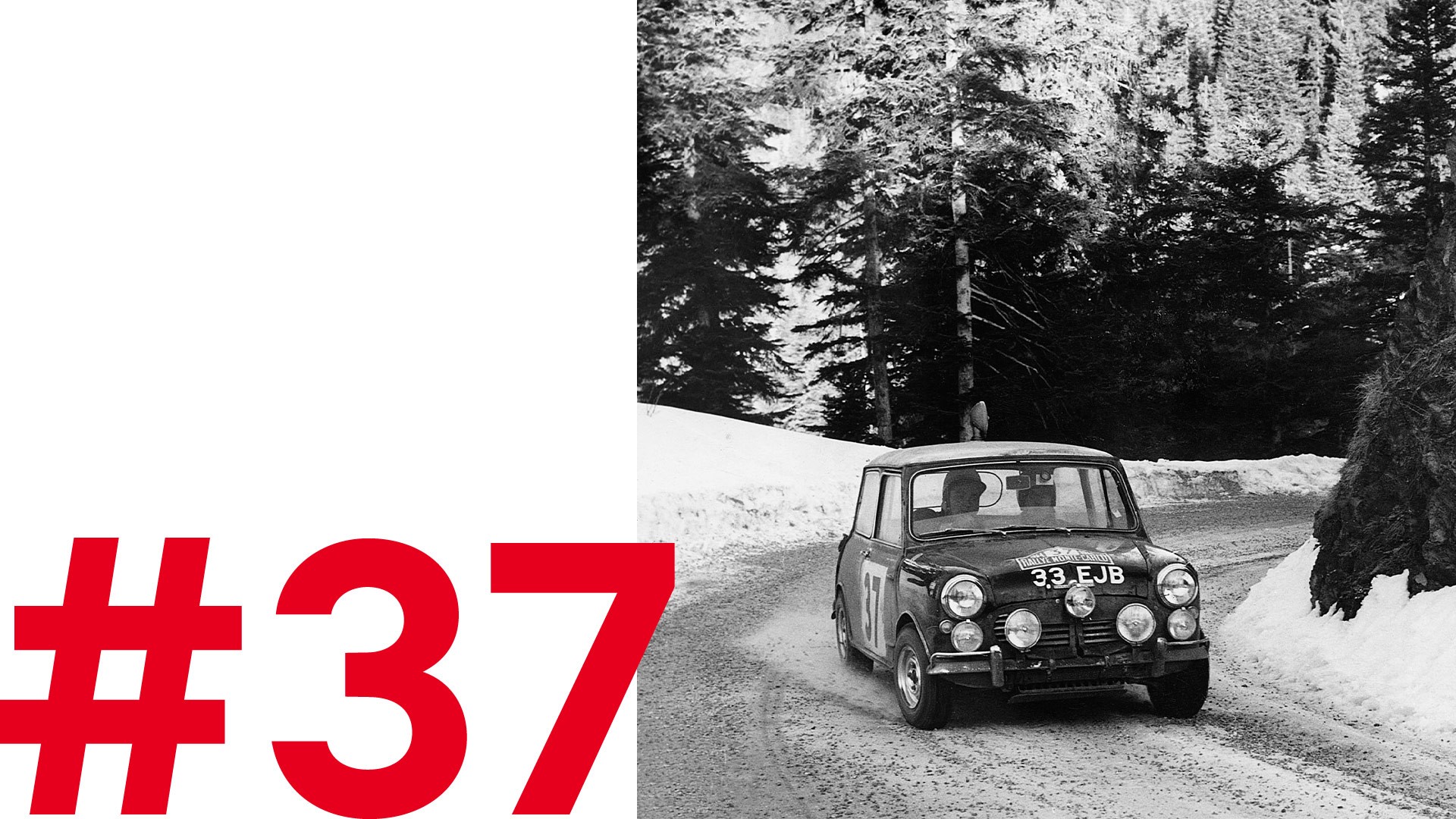
THREE MUSKETEERS.
ONE MINI.
UNLIMITED OPTIMISM.
Six works cars were sent into the race that year; three finished in the top ten and ushered in the era of the ‘Three Musketeers’, consisting of Patrick Hopkirk, Timo Mäkinen, and Rauno Aaltonen. However, the immense success that caused worldwide furore had little to do with luck or chance. Only through the efforts of the engineers and drivers, the special design of the Mini, and an inexhaustible belief could history be made in the 1960s.
In line with Darwin’s theory, the little Cooper proved that it is not the most powerful but the most adaptable that comes out on top: its low weight, long wheelbase, short body transitions, and irresistible handling made it particularly agile and mitigated any performance deficit. Exceptional talent Hopkirk trained incessantly in the snow and was able to fully utilise the potential of the car, which proved similar to a go-kart in its handling.
Added to this was the team’s logistical masterstroke. So-called ‘Ice Spies’ scouted the location of critical sections on the track and radioed important information to the drivers during the race. According to Charlie, there was another decisive factor which determined the outcome: ‘Perhaps the ultimate difference was the team’s underdog spirit – a bunch of Brits, in the swinging sixties, high on optimism and the belief that they could conquer anything.
’One thing is certain; without one person in particular, none of this would have come about in the first place.
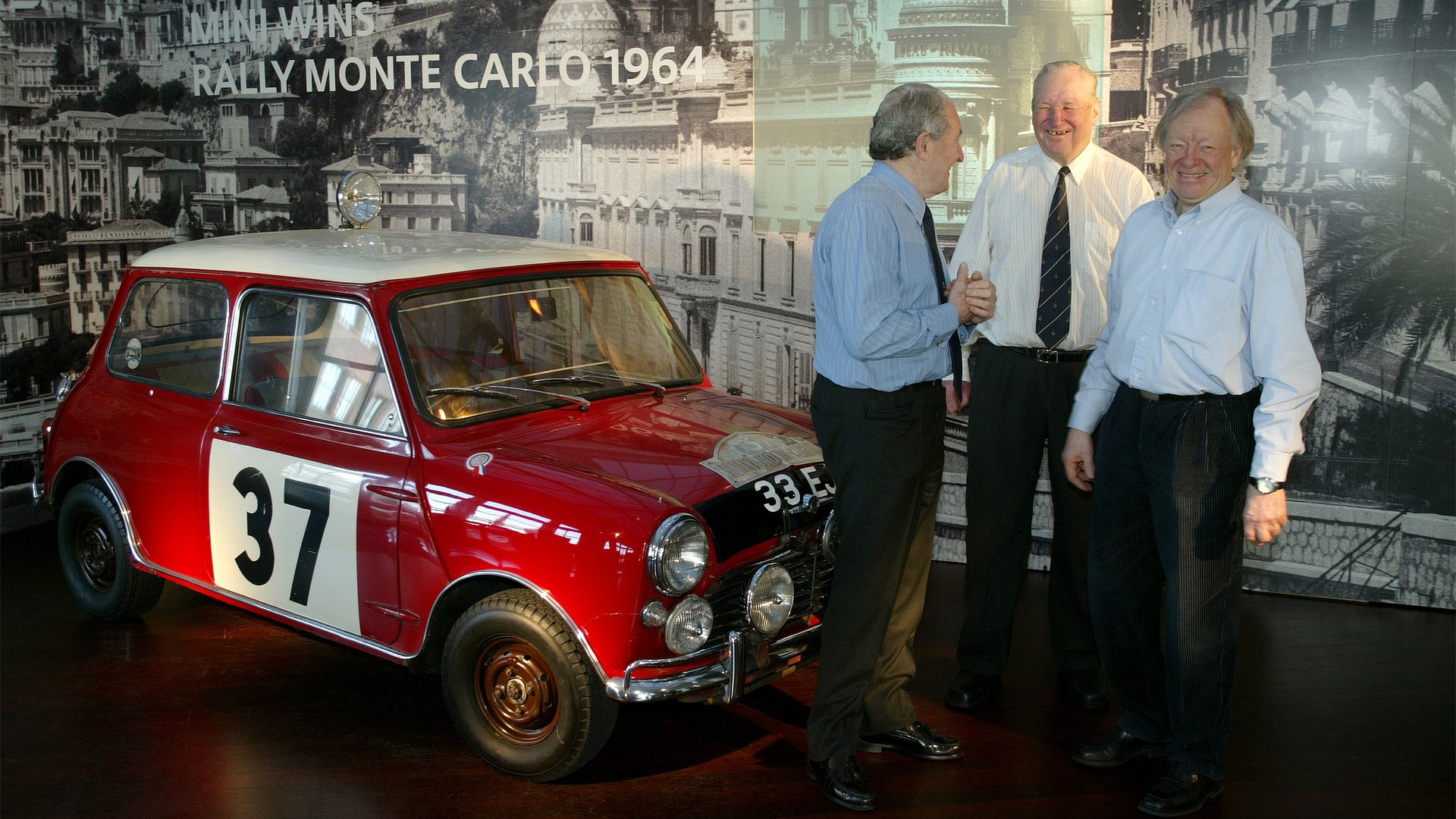
Monte Carlo RallY
Milestones.
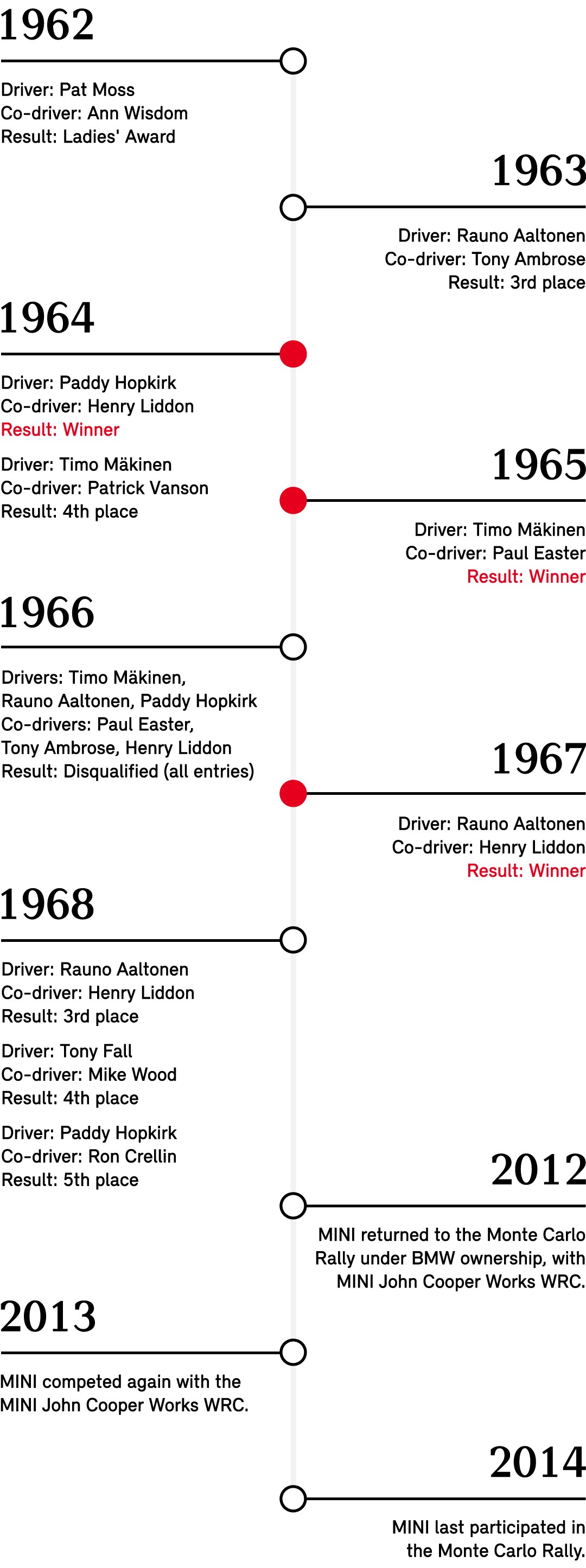

FROM INSIDER TIP TO
GLOBAL PHENOMENON.
Long before designer Alec Issigonis scribbled the first Mini sketch on a piece of paper, he and John Cooper had formed a deep friendship. Cooper – whose father owned a workshop himself – installed Morris engines, and Issigonis repeatedly sought the advice of the keen designer, who had already made a name for himself with his own Formula 2 and 3 racing teams. But the BMC management was sceptical about Cooper’s plans to modify the Mini and send it into tarmac competitions. ‘They couldn't envision the Mini as a race car at all. However, my grandfather’s persistence and initial domestic, on-track success eventually won them over,’ relates Charlie. This persistence quickly paid off: in 1962, the souped-up Mini took the first podium places on prominent rally circuits. The cult car was born.
Having proved itself, the Classic Mini was off to the prestigious Monte Carlo circuit. What Hopkirk achieved in 1964 was replicated by Mäkinen the following year without picking up a single penalty point. The Three Musketeers were unstoppable, even when dreams of a hat-trick were shattered by a debatable disqualification in 1966. Despite Rauno Aaltonen’s rallying and claiming the hattrick in 1967, the golden years were up in 1970, when the competition caught up strongly and made a comeback. But the end of rally dominance was only the beginning of a historic global success for the MINI brand.
TYPICAL MINI. BUT ALWAYS DIFFERENT.
MINI set itself the goal of fulfilling the individual wishes of every car enthusiast. Thus, new production facilities and models such as the MINI Clubman or the MINI Convertible emerged. The focus of numerous edition models ranged from sporty and elegant to youthfully cheeky, but always maintaining the traditional sporting spirit and British flair. Over the decades, the MINI brand has reinvented itself time and again: offering increasing comfort due to high-quality materials, technical expertise, and more and more options for individualisation. A MINI has been created to suit every type of surface and to accommodate every lifestyle.
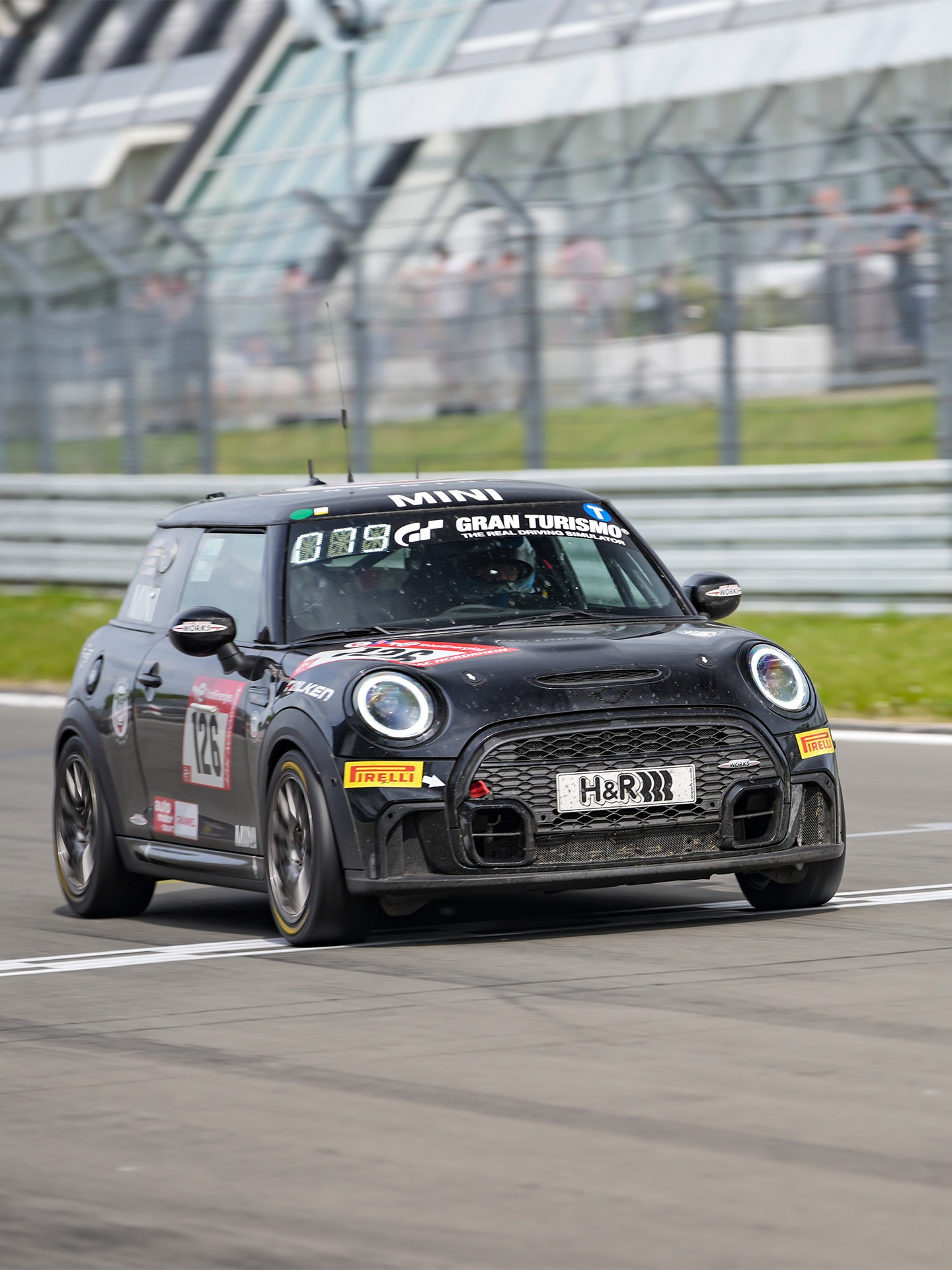
The displayed vehicle is not a series production car and not for sale.
BLOOD, SWEAT, FAITH.
THE COOPER LEGACY.
John Cooper passed on his love of customising cars to his son, Michael. At the beginning of the 2000s, Michael founded a company specialising in tuning equipment called John Cooper Works. His first car was, unsurprisingly, a red Mini. Now, the legacy continues into its fourth generation, with Michael’s son Charlie also being a racing driver who deeply feels the same ‘entrepreneurial spirit and love of racing and motorsport’.
For Charlie, this passion is a part of his DNA: ‘I still make it a point to ring up my old man after every Formula 1 race. It’s like our post-race analysis – a tradition that’s as ingrained as Sunday roasts.’ There was a time when Charlie tried to pursue a different path, away from the Cooper career. It was a rebellious phase that ended abruptly. ‘The gravitational pull of the brand was too strong; it feels like being home after a necessary detour. I’m so glad to be back working with MINI and BMW Group, keeping the Cooper family’s authentic spirit alive and keeping one foot in motorsport’, states Charlie.
Charlie recently climbed the famous Col de Turini in a red Classic Mini with contrasting white roof, tracing the same asphalt his grandfather conquered 60 years ago with adrenaline and fighting spirit. In 2023, he also participated in the 24-hour race at the Nürburgring – one of the most challenging contests in the world – and secured a podium finish in a MINI John Cooper Works. Even today, MINI continues celebrating big firsts.
ON THE TRACKS OF HISTORY.
THE ELECTRIFIED GO-KART FEELING.
A lot has happened to the MINI Cooper over the last six decades. Its limits have been pushed and pushed again; style, vehicle technology, and functionalities have been continuously optimised. Yet the iconic features that were crucial to the Monte Carlo victory in 1964 can still be found in MINI models today: front-wheel drive, transverse-mounted engines, short body transitions, compact dimensions.
MINI remains a nimble companion that guarantees unparalleled driving pleasure and makes sportiness on four wheels suitable for everyday use. And while the charm of the original design endures, its performance has increased considerably, amplifying the characteristic go-kart feeling.
THE RALLY COOPER COMPARED TO THE LATEST MINI COOPER S.
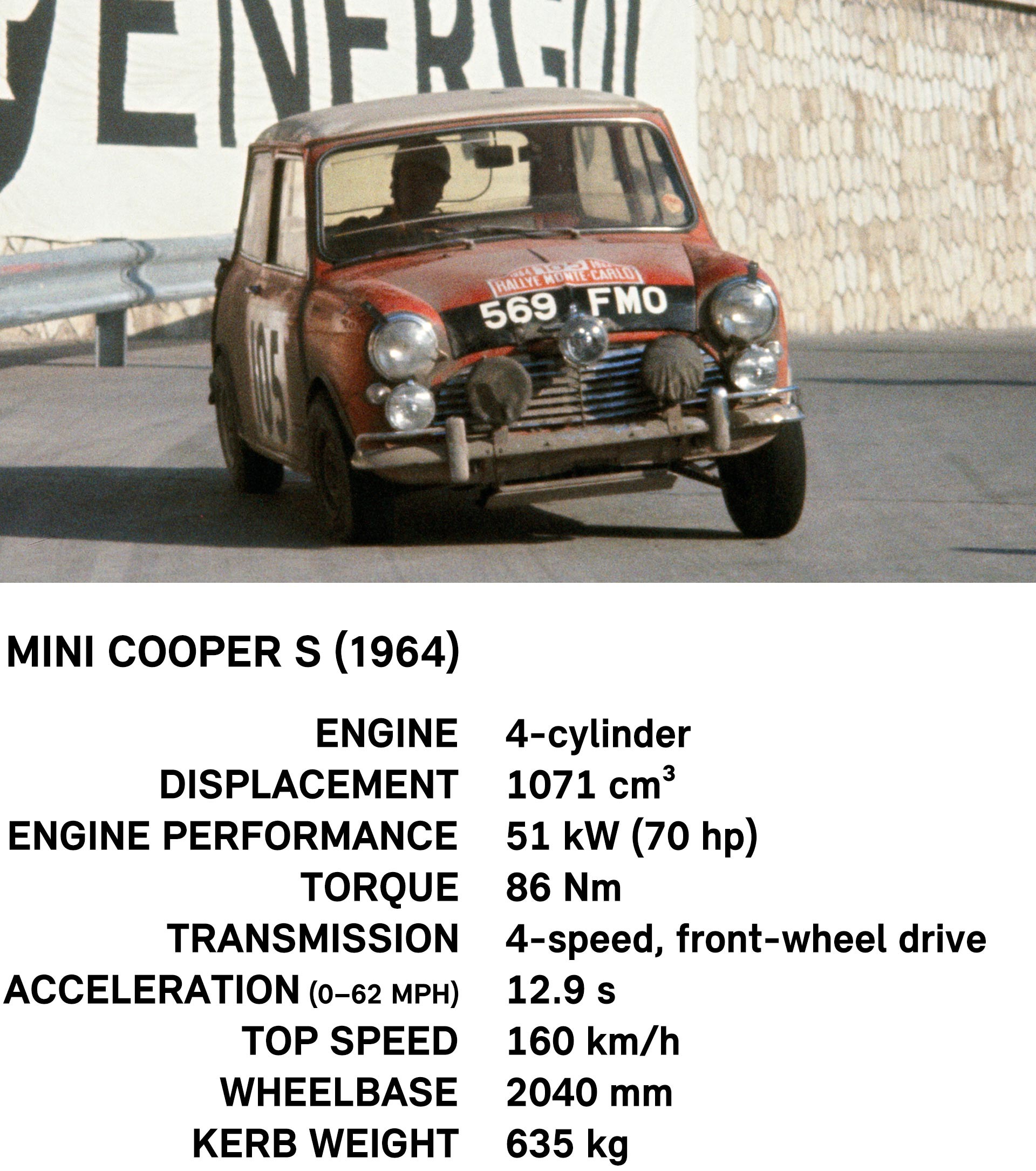
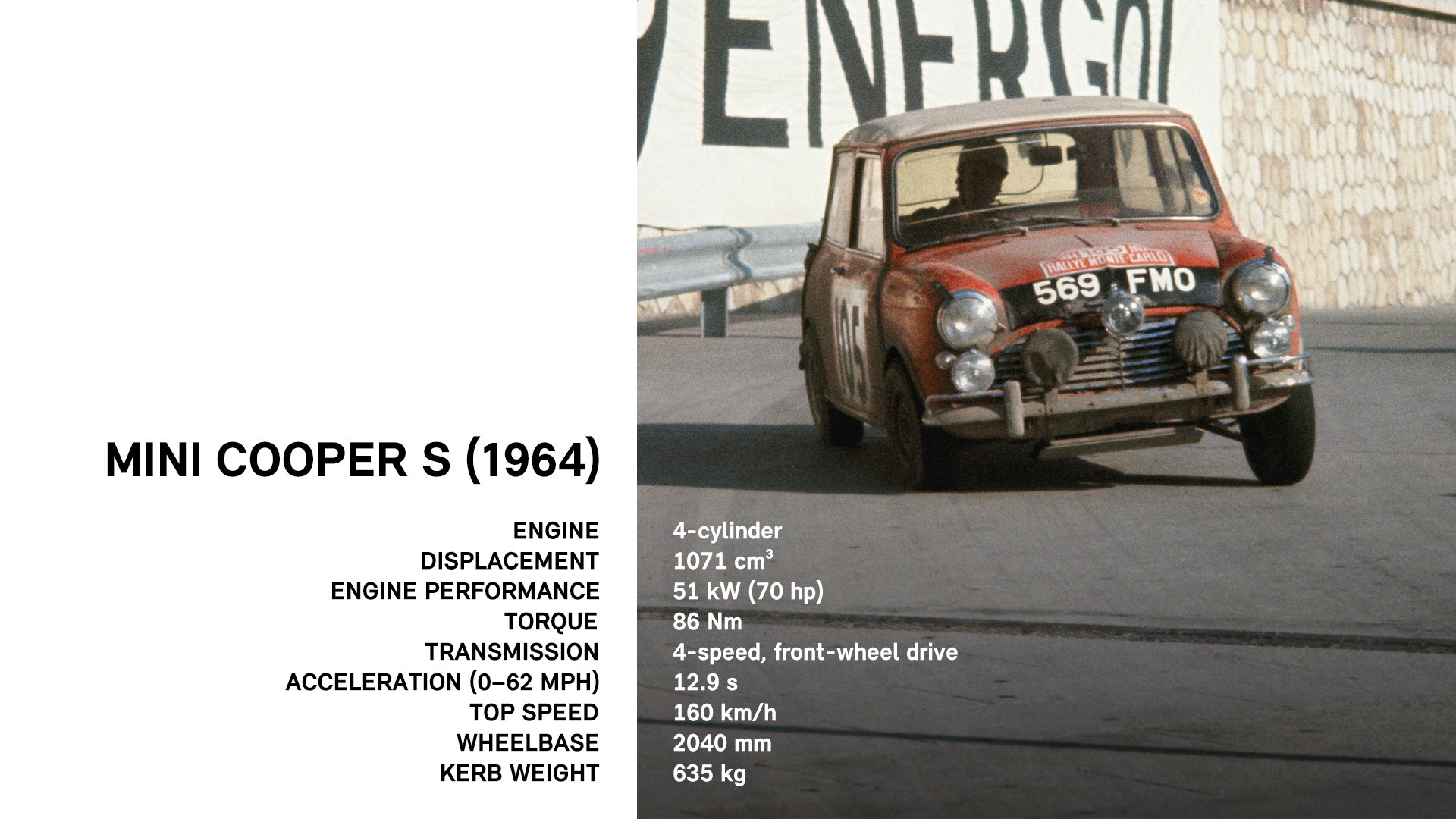
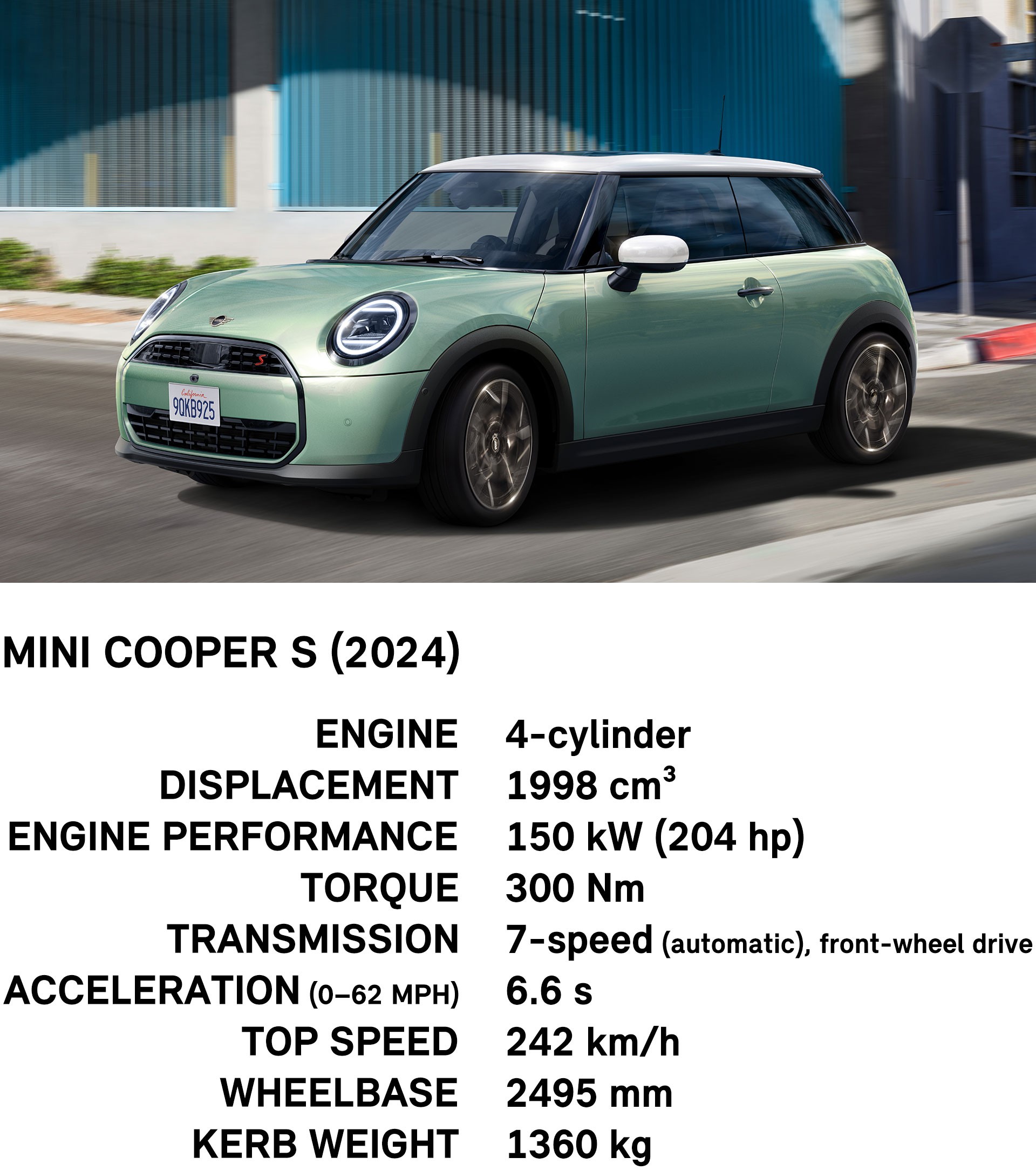
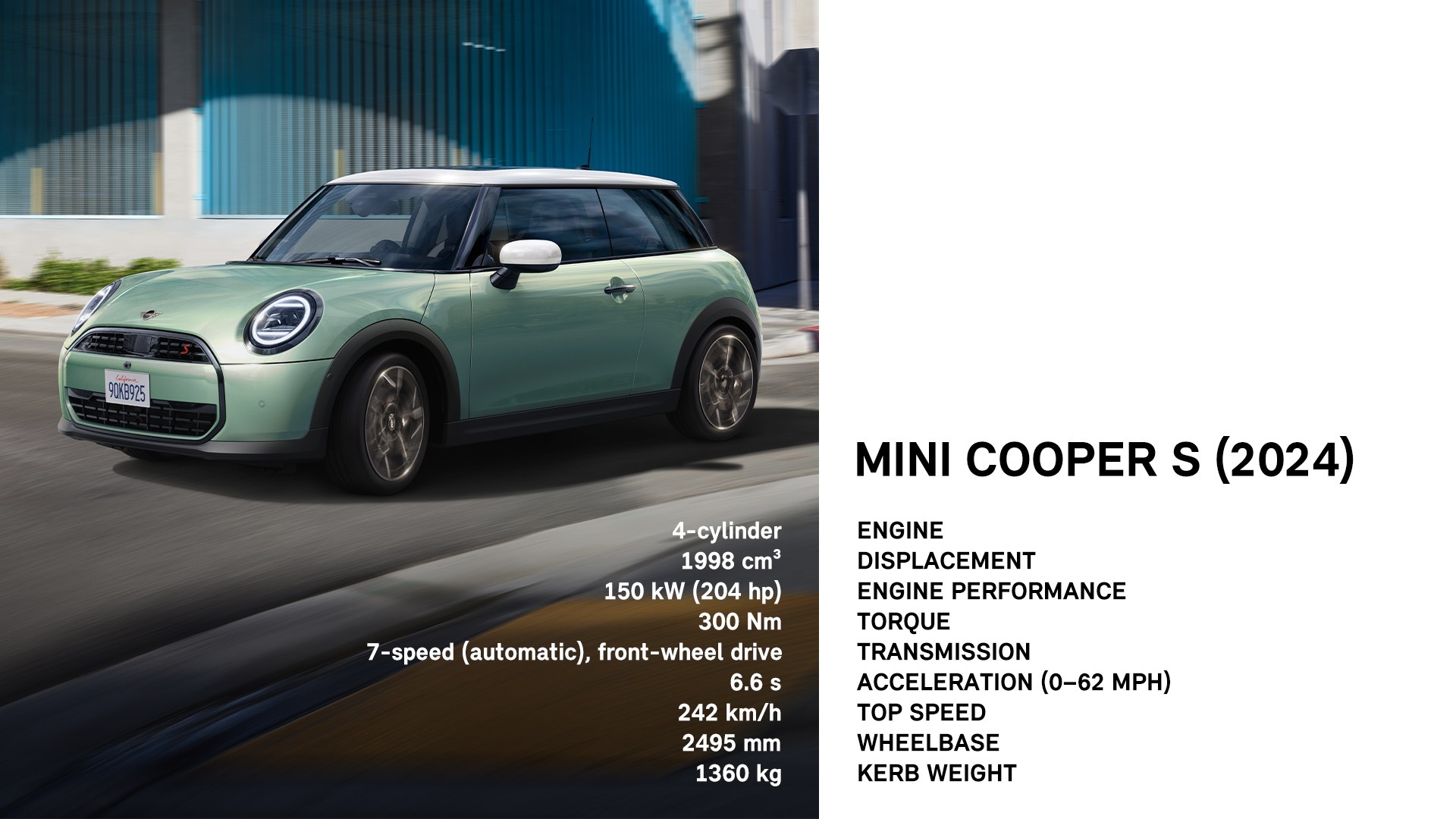
MINI COOPER S Mandatory information according to german law ’Pkw-EnVKV’ based on WLTP: energy consumption combined: 6,4 l/100 km; CO₂ emissions combined: 144 g/km;CO2-class: E. Values are based on WLTP and relate to the MINI Cooper S, 18" Slide Spoke 2-tone, Classic Trim, Package L (see depiction). Availability depends on country. Further information on the official fuel consumption and official specific CO2 emissions of new passenger cars can be found in the 'Guide to Fuel Consumption, CO2 Emissions and Power Consumption of New Passenger Cars', which is available free of charge at all sales outlets in Germany, from Deutsche Automobil Treuhand GmbH (DAT), Hellmuth-Hirth-Str. 1, 73760 Ostfildern-Scharnhausen, and from https://www.dat.de/co2/.
Now, a double relaunch of the original brings the icon into a forward-looking era: the new all-electric MINI family focuses on sustainability and transfers modern standards to the ingenious, tried-and-tested vehicle and drive concept.
For Charlie, this next step fits right in with the MINI philosophy: ‘Going all electric makes perfect sense for the brand – embracing electric technology not only aligns with the shift towards sustainability but also brings a host of benefits to the iconic MINI go-kart driving experience. My grandfather would have loved the electric revolution.’
MINI tradition – which has stood for driving fun, thrills, and the courage to be different over the course of six decades and four generations – lives on with Charlie as it enters a new, electric age.
Charlie, who has already tested the new generation, is particularly fond of the upcoming John Cooper Works models. To him, the cars feel agile, nimble, and remarkably well-balanced. ‘It’s the kind of driving experience that puts a grin on your face – that signature MINI grin.’
Last year, he took to the stage with Stefanie Wurst, Head of MINI, and rally legend Rauno Aaltonen to present the new electric MINI Cooper. And as he looks to the future, Charlie plans on continuing in the footsteps of his father and grandfather, cooperating to keep the unmistakable rebellious spirit alive: ‘It certainly feels like being part of a revolution, a nod to the future of racing with an electric pulse.’ It’s a Cooper with a MINI Cooper in the spotlight, who embodies ‘the joy of the ride, the thrill of competition, and the camaraderie that came with it.’
Somehow, it all sounds familiar.
